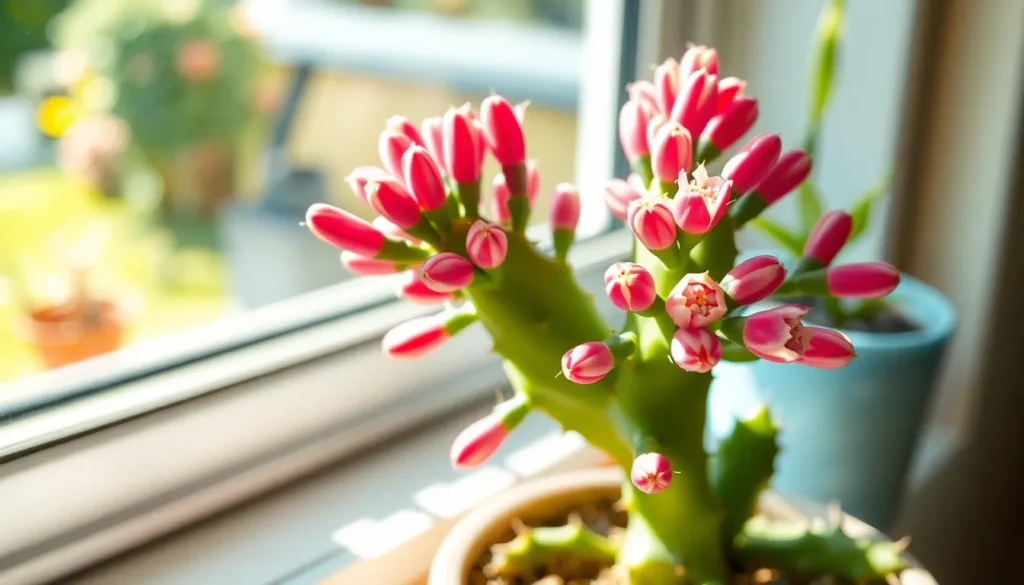We’ve all been there – admiring those gorgeous Christmas cactus plants in the store, only to watch them struggle once we bring them home. These stunning holiday bloomers aren’t your typical desert cacti, and that’s exactly where most people go wrong with their care routine.
The good news? Christmas cacti are actually quite forgiving once you understand their unique needs. Unlike their prickly cousins, these tropical beauties thrive with more water, indirect light, and exact temperature conditions that trigger their spectacular winter blooms.
Whether you’re a seasoned plant parent or just starting your indoor garden journey, we’ll walk you through everything you need to know to keep your Christmas cactus healthy and blooming year after year. From proper watering techniques to the secret behind encouraging those coveted holiday flowers, you’ll discover why these plants make such rewarding additions to any home.
Understanding Your Christmas Cactus Plant’s Basic Needs
Christmas cacti thrive when we provide them with conditions that mimic their native tropical rainforest environment. These plants require exact care parameters that differ significantly from their desert cousins.
Light Requirements and Placement
Bright, indirect light serves as the foundation for healthy Christmas cactus growth. We should position these plants near east or north-facing windows where they receive gentle morning light without harsh afternoon sun exposure. Direct sunlight can scorch their delicate leaves, causing them to turn yellow or develop brown patches.
Fluorescent lighting works well for Christmas cacti in offices or rooms with limited natural light. We recommend placing them 12 to 18 inches away from artificial light sources to prevent overheating. During the blooming season, consistent lighting helps maintain flower production and prevents premature bud drop.
Rotating your Christmas cactus every few weeks ensures even growth on all sides. We’ve found that plants placed in consistently bright locations develop fuller, more symmetrical shapes compared to those in darker corners.
Temperature Preferences
Christmas cacti prefer temperatures between 65°F and 70°F during their active growing season. We maintain these moderate temperatures to encourage healthy leaf development and robust root systems. Extreme temperature fluctuations can stress the plant and cause leaf segments to drop.
Cooler temperatures ranging from 50°F to 60°F during fall months trigger the blooming process. We create these conditions by moving plants to unheated rooms or placing them near cooler windows for 6 to 8 weeks before the desired blooming period. This temperature drop signals the plant to begin forming flower buds.
Avoiding heat sources like radiators, heating vents, and fireplaces protects Christmas cacti from temperature stress. We keep these plants away from drafty areas where cold air can cause sudden temperature drops that damage sensitive tissues.
Humidity Levels
Christmas cacti flourish in humidity levels between 50% and 60%, which mimics their tropical origins. We increase humidity around these plants using several effective methods that don’t require expensive equipment. Grouping multiple plants together creates a natural humidity microclimate through transpiration.
Pebble trays filled with water provide consistent moisture without waterlogging the soil. We place these trays beneath the plant containers, ensuring the pots don’t sit directly in standing water. The evaporating water increases local humidity levels around the Christmas cactus leaves.
Misting the air around the plant once or twice weekly supplements humidity during dry winter months. We avoid spraying water directly on the leaves to prevent fungal issues and instead focus on misting the surrounding air space.
Choosing the Right Soil and Potting Mix
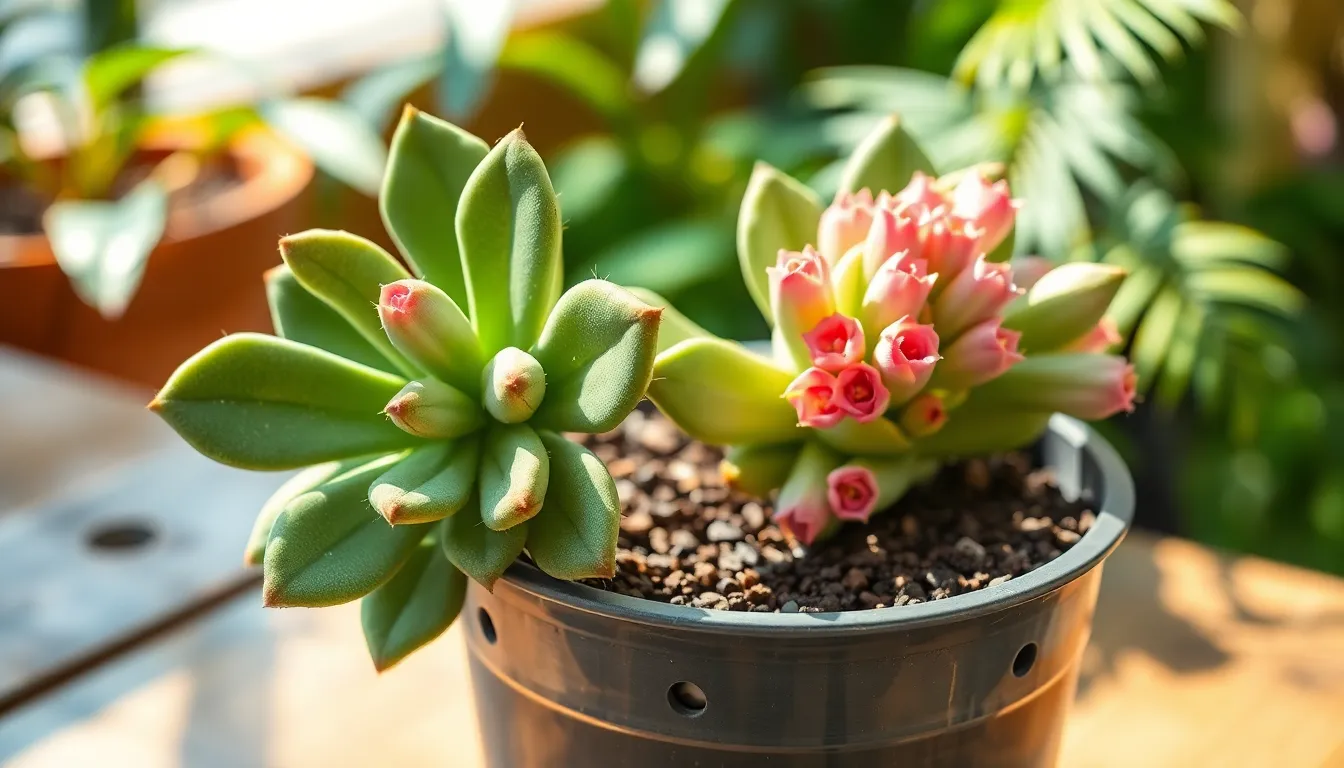
Christmas cacti need well-draining soil that mimics their tropical rainforest origins. We’ll explore the essential soil requirements and repotting considerations to keep your holiday cactus thriving.
Best Soil Types for Christmas Cacti
Sandy cactus mix provides the perfect foundation for Christmas cactus growth, offering excellent drainage while maintaining essential moisture. We recommend using a specialized cactus/succulent potting soil blend enhanced with perlite for optimal root health.
Standard potting soil mixed with sand or perlite creates an effective alternative that balances moisture retention with proper drainage. This combination prevents the soggy conditions that often lead to root rot in Christmas cacti.
Avoiding dense, heavy soils is crucial since these retain excessive water and create unhealthy growing conditions. We’ve found that lightweight, airy soil mixes produce the strongest and most vibrant Christmas cactus plants.
Drainage Considerations
Proper drainage prevents the waterlogged conditions that quickly damage Christmas cactus roots. We always use pots with drainage holes to allow excess water to escape freely from the soil.
Testing soil moisture before watering ensures your plant receives the right amount of hydration. We check the top 1-2 inches of soil and only water when this layer feels dry to the touch.
Reducing watering frequency during the flowering season helps the plant rest and prevents moisture-related problems. This practice supports healthy blooming while avoiding the overwatering issues that commonly cause Christmas cactus decline.
When to Repot
Christmas cactus plants prefer slightly pot-bound conditions, so frequent repotting isn’t necessary for healthy growth. We typically repot these plants every 2-3 years to maintain optimal soil conditions.
Spring timing works best for repotting since it occurs just after the flowering period ends. This schedule avoids disturbing the plant during its important bloom cycle.
Recognizing repotting signs helps determine the right timing for your exact plant. We look for plants that have outgrown their current containers or show signs of compacted soil that no longer drains properly.
Mastering the Watering Schedule
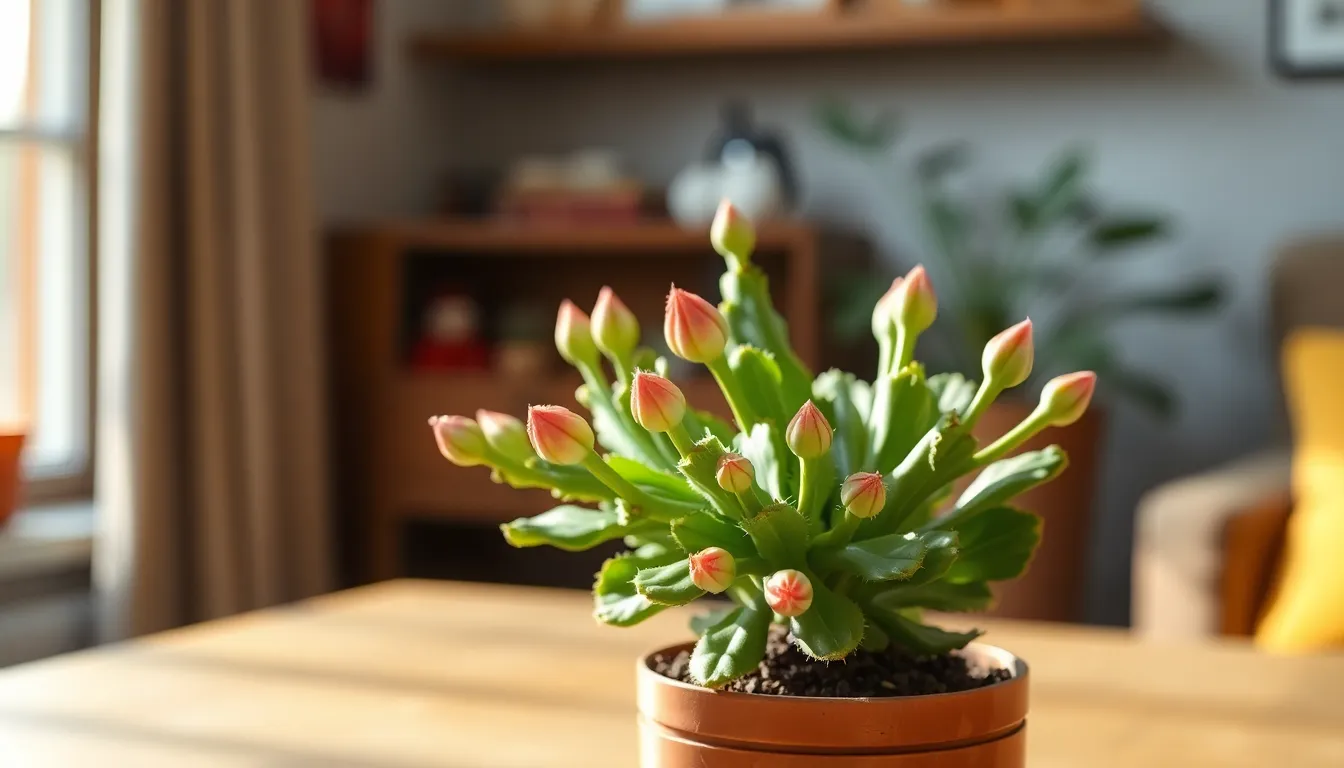
Getting the watering schedule right makes the difference between a thriving Christmas cactus and a struggling plant. We’ve found that understanding your plant’s unique moisture needs prevents most common care problems.
How Often to Water
Watering every 1 to 2 weeks works best for Christmas cacti, allowing the top half of the potting soil to dry out between waterings. We recommend checking the soil moisture by inserting your finger about 2 inches deep into the potting mix. During spring and summer growing seasons, we maintain consistent moisture levels without creating waterlogged conditions.
Feel the soil before each watering session to confirm dryness at the halfway point down the pot. After your Christmas cactus finishes flowering, we stop watering for approximately 30 days to encourage the plant’s natural rest cycle. Resume regular watering when you notice new growth emerging from the stems.
Signs of Overwatering vs. Underwatering
Overwatered Christmas cacti develop soggy soil that doesn’t drain properly, leading to dangerous root rot conditions. We notice yellowing leaves that feel soft and mushy to the touch as the primary warning signs. Excess water sitting in the potting mix creates an environment where harmful bacteria and fungi can thrive.
Underwatered plants show completely different symptoms that we can easily identify through visual inspection. Soil feels dry several inches below the surface, and leaves become shriveled or wrinkled in appearance. Premature leaf drop often occurs when we allow the potting mix to stay too dry for extended periods.
Seasonal Watering Adjustments
Autumn watering requires important reduction starting in mid September until flower buds begin developing on the stems. We decrease watering frequency during this crucial period because cooler temperatures and shorter daylight hours trigger the plant’s natural blooming cycle. Minimal water during autumn rest periods encourages robust flower bud formation.
Flowering season demands increased watering attention once buds appear, but we avoid overwatering until the colorful blooms fade completely. Winter care from late January through late March involves another rest period with reduced watering to maintain healthy blooming cycles. Spring signals the return to regular watering schedules as new growth emerges and temperatures warm up.
| Season | Watering Frequency | Key Notes |
|---|---|---|
| Spring/Summer | Every 1-2 weeks | Keep soil moist but not soggy |
| Autumn | Minimal | Reduce from mid-September |
| Flowering | Moderate | Increase when buds appear |
| Post-flowering | Reduced | 30-day rest period recommended |
Providing Proper Light Conditions Throughout the Year
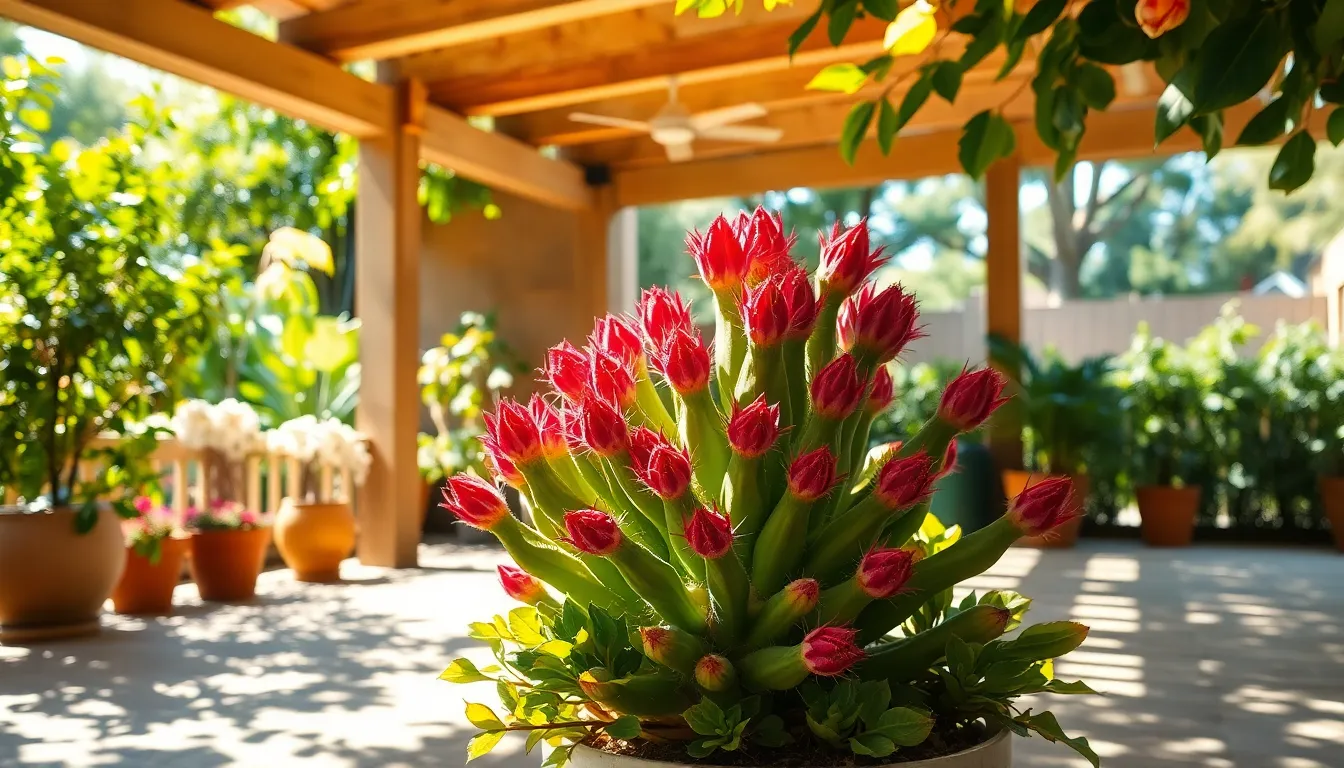
Managing light exposure throughout the seasons is essential for healthy growth and spectacular blooming. We’ll guide you through the exact lighting needs your Christmas cactus requires during each season to ensure optimal health and flowering.
Summer Light Requirements
Bright indirect light outdoors provides the perfect summer environment for your Christmas cactus. We recommend moving the plant to a shaded outdoor location where it receives filtered sunlight rather than harsh direct rays. Partial shade protection prevents leaf bleaching and burning, which commonly occurs when plants receive too much intense summer sun.
Position your cactus under a covered patio or beneath tree canopy to create ideal growing conditions. Avoid placing the plant in full sun exposure, as this causes stress and can permanently damage the delicate leaf segments. Outdoor conditions during summer months promote active growth when combined with proper humidity and temperature control.
Fall Light Management for Blooming
Cool temperatures and extended darkness periods trigger bud formation during the critical fall months. We need to provide 12 to 14 hours of uninterrupted darkness daily for 6 to 8 weeks to encourage flower development. Move your Christmas cactus indoors before the first frost to protect it from temperature damage.
Maintain room temperatures between 50°F and 55°F during this blooming preparation period. Keep the plant in a cool, dark location such as a basement, spare bedroom, or unheated room where artificial lighting won’t interfere with the darkness cycle. Reduce watering frequency during fall preparation to create slight drought stress, which further encourages bud formation.
Avoid exposing the plant to streetlights or indoor lighting during nighttime hours, as even small amounts of light can disrupt the blooming process.
Winter and Spring Light Needs
Diffused light for 4 to 6 hours daily supports healthy flowering throughout the winter blooming season. We recommend placing your Christmas cactus near a bright window with filtered light or using sheer curtains to soften direct sunlight. Temperatures between 60°F and 70°F create optimal blooming conditions during the winter months.
Position the plant away from heat sources like radiators, fireplaces, or heating vents that can cause temperature fluctuations. Maintain consistent lighting conditions throughout the blooming period to prevent bud drop and ensure full flower development.
Spring care involves continued moderate indirect light as the plant transitions from flowering to growth mode. Feed your Christmas cactus with half strength balanced fertilizer in early spring after the blooming period ends. Avoid fertilizing during active flowering to prevent interfering with the natural bloom cycle. Gradually increase watering frequency as daylight hours extend and the plant enters its active growing phase.
Monitor leaf color as an indicator of proper light exposure – healthy segments should remain deep green without yellowing or reddish tinting that indicates light stress.
Creating the Perfect Temperature Environment
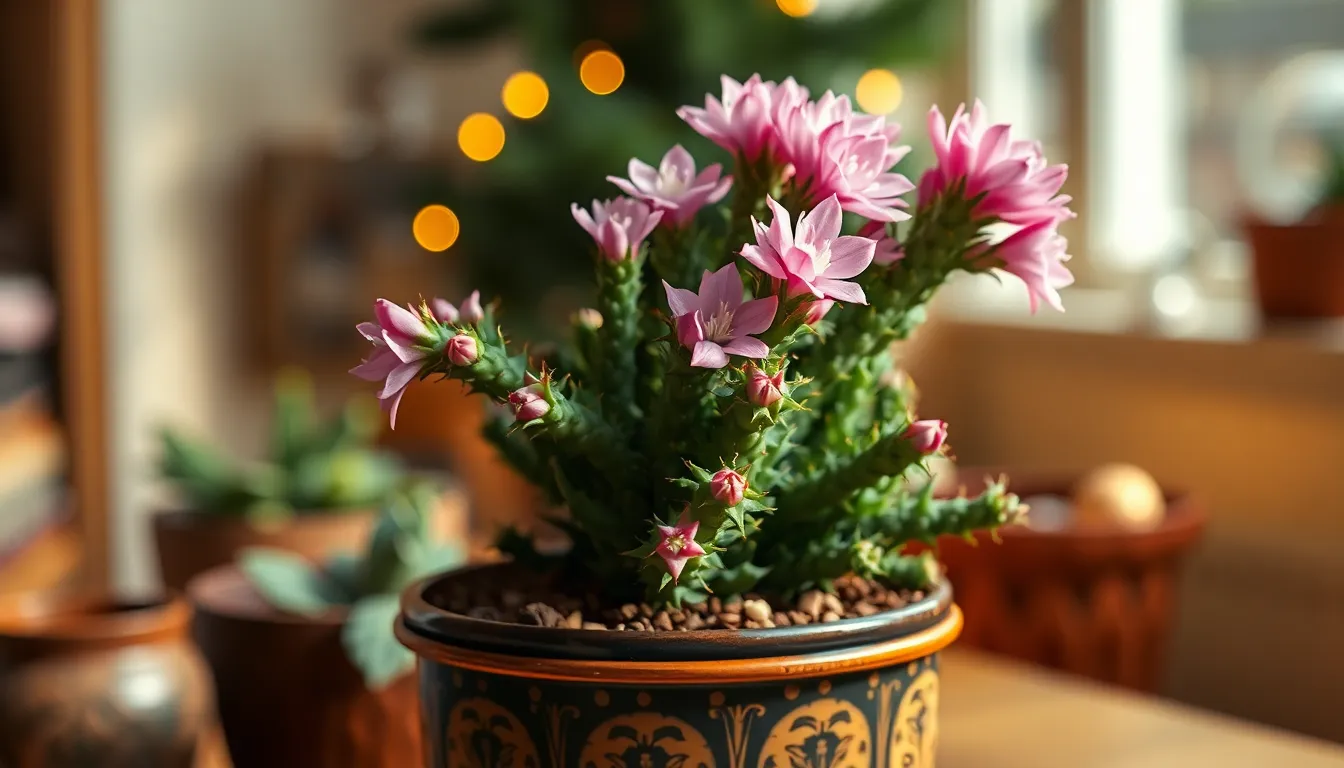
Temperature control plays a vital role in Christmas cactus care and directly impacts both growth and flowering success. Managing these temperature requirements properly ensures your plant thrives throughout its natural seasonal cycles.
Ideal Temperature Ranges
Growing season temperatures between 65°F and 70°F (18°C to 21°C) create optimal conditions for Christmas cacti during spring and summer months. We recommend maintaining this warm range consistently to support healthy foliage development and robust plant growth.
Bud formation requires cooler daytime temperatures ranging from 55°F to 65°F (12°C to 18°C) when you want to encourage flowering. Nighttime temperatures should drop slightly lower to 45°F to 55°F (7°C to 13°C) during this critical period.
Fall temperature drops to 50°F to 55°F (10°C to 13°C) for 6 to 8 weeks trigger the blooming process needed for holiday flowers. This controlled cooling period mimics the plant’s natural environment and signals the cactus to begin bud development.
Avoiding Temperature Extremes
Cold exposure below 50°F (10°C) for extended periods can seriously damage your Christmas cactus and should be avoided at all costs. Prolonged cold stress often leads to leaf drop, root damage, and compromised plant health that takes months to recover from.
Heat sources like heating ducts, radiators, and fireplaces create dangerous temperature fluctuations that stress the plant. We suggest keeping your Christmas cactus away from these areas to prevent sudden temperature changes that cause bud drop.
Excessive warmth above 75°F (24°C) during the bud setting period actively inhibits flower formation and can prevent blooming entirely. Cold drafts from windows, doors, and air conditioning vents pose equal threats to plant stability and should be avoided.
Seasonal Temperature Changes
Autumn management involves relocating your plant to a cooler environment around 50°F to 55°F for several weeks while simultaneously reducing watering frequency. This combination of cooler temperatures and drier conditions promotes healthy bud development for winter blooming.
Winter blooming period calls for returning to moderately warm temperatures around 65°F to 70°F once flower buds appear on the plant. We recommend resuming regular watering schedules during this phase to support the energy demands of flowering.
Post flowering rest from late winter through early spring benefits from another cooler period at 55°F to 59°F to encourage new growth. This temperature cycle prepares your Christmas cactus for the next growing season and maintains its natural rhythm for continued health and future blooming success.
Fertilizing Your Christmas Cactus for Optimal Growth
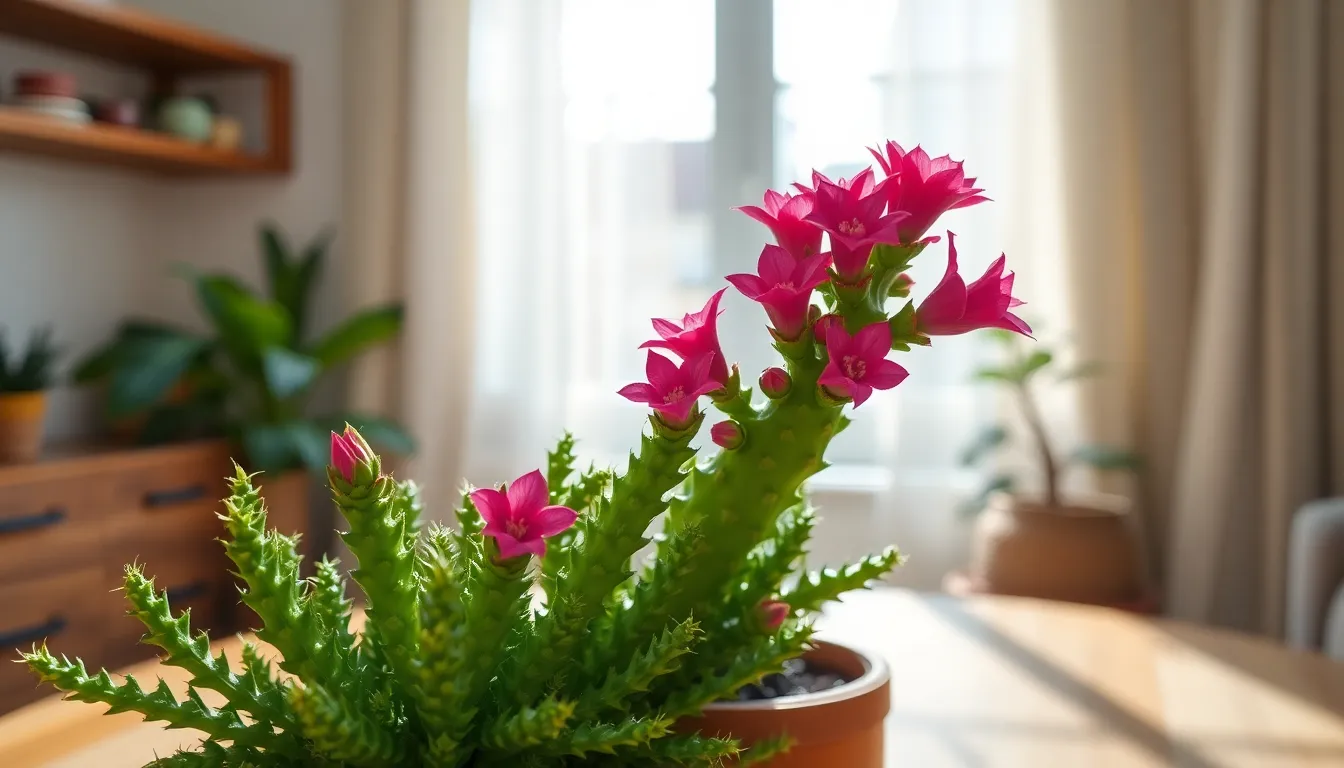
Christmas cacti require careful nutrient management to support healthy growth without interfering with their natural blooming cycle. Understanding when and how to feed these tropical plants ensures they’ll produce vibrant flowers year after year.
Best Fertilizer Types
Balanced water-soluble houseplant fertilizers work best for Christmas cacti, providing equal or near-equal parts nitrogen, phosphorus, and potassium. We recommend formulas like 10-10-10 or 20-20-20 diluted to half strength to prevent nutrient burn on these sensitive plants.
Standard houseplant fertilizers offer the gentle nutrition Christmas cacti need without overwhelming their delicate root systems. Diluting the fertilizer to half the recommended strength protects against over-fertilization while still delivering essential nutrients.
Avoid feeding during the blooming period completely, as excess nutrients can actually hinder flower production and reduce the quality of your holiday display. This timing restriction is crucial for maintaining the plant’s natural flowering cycle.
Feeding Schedule
Feed your Christmas cactus once yearly in spring, immediately after the flowering period ends, using the diluted balanced fertilizer. This single annual feeding provides sufficient nutrients for the entire growing season without disrupting the plant’s natural rhythms.
Spring feeding during the main growing season supports new growth and segment development when the plant is most actively producing foliage. Early summer can serve as an alternative feeding time if you missed the post-bloom window.
Skip fertilizing during autumn and winter months when the plant enters its dormant phase and prepares for blooming. This nutrient restriction helps trigger the natural processes needed for bud formation and flower development.
Signs Your Plant Needs Nutrients
Slow or stunted growth indicates your Christmas cactus may need nutrients, especially if environmental conditions like light and temperature are optimal. Healthy plants should produce new segments regularly during the growing season.
Pale or yellowing leaves often signal nutrient deficiency when the plant receives adequate light and proper watering. These color changes typically appear first on older segments before affecting new growth.
Reduced blooming or complete absence of flowers may result from nutrient stress, particularly if fertilizer has been withheld for multiple years. But, environmental factors like insufficient darkness periods can also cause blooming issues, so evaluate all care conditions before assuming nutrient deficiency.
Pruning and Maintaining Plant Shape
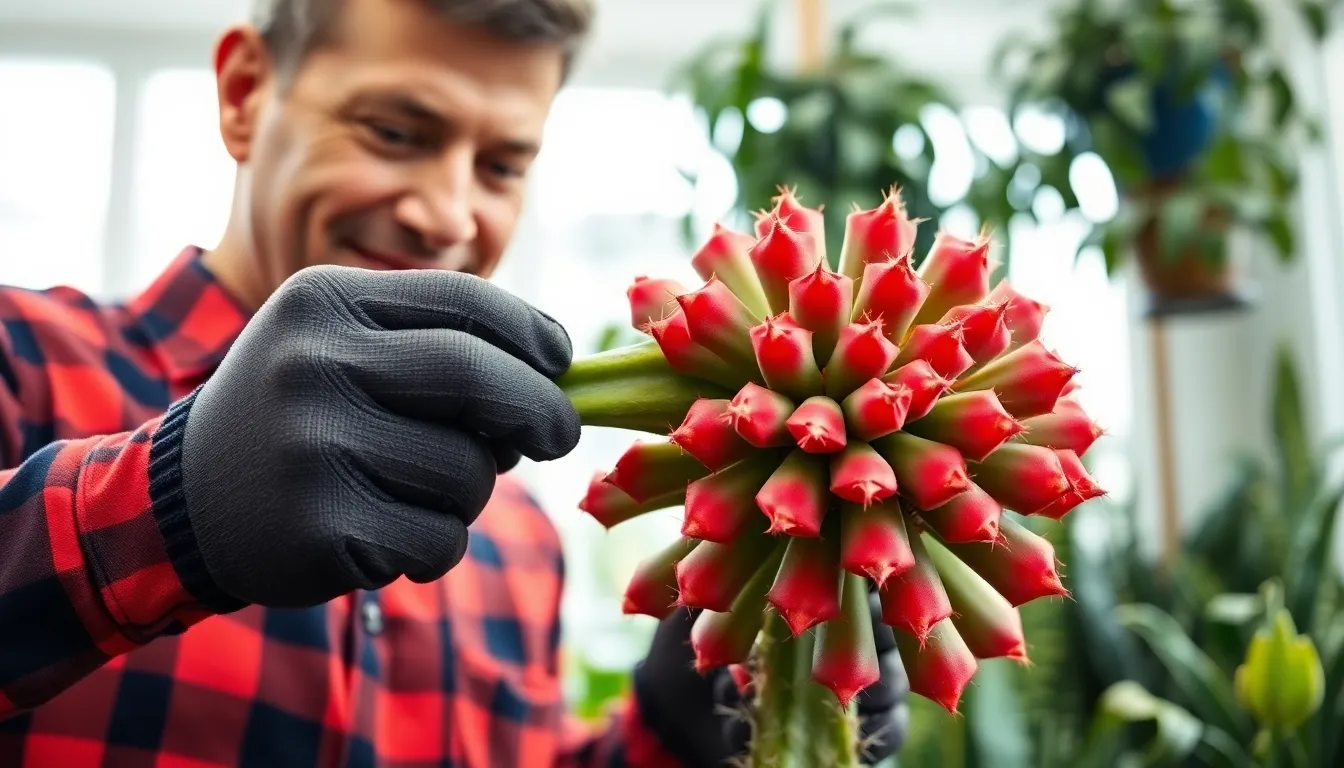
Maintaining your Christmas cactus’s shape through proper pruning ensures vigorous growth and abundant blooms for years to come. Strategic trimming also provides opportunities to propagate new plants from the cuttings.
When to Prune
Timing your pruning correctly maximizes your Christmas cactus’s growth potential and flowering capacity. We recommend pruning immediately after the blooming period ends, which typically occurs during the plant’s new growth phase extending through late spring.
This timing allows your plant to focus its energy on developing new stems and branches rather than supporting existing growth. Pruning during this period from just after bloom to late spring won’t harm your plant and actually encourages healthier development.
Proper Pruning Techniques
Gentle segment removal preserves your Christmas cactus’s natural structure while promoting fuller growth. We suggest gently twisting off segments between the flat leaf-like joints, which is the plant’s preferred separation method.
Sharp, sterilized tools work effectively if you prefer cutting over twisting. Use clean scissors or a knife to cut segments at the natural joint connections, ensuring you don’t damage surrounding tissue.
Conservative pruning involves removing one to two segments from each stem’s end, while more aggressive pruning allows removal of up to one-third of the entire plant annually. Both approaches encourage branching and help maintain your plant’s desired shape.
Propagating from Cuttings
Easy propagation from pruned segments lets you expand your Christmas cactus collection or share plants with friends. Simply collect the segments you’ve removed during pruning and let them dry for one to two days.
Plant the dried segments in moist, well-draining soil, ensuring good contact between the cutting and growing medium. Position your new cuttings in indirect light and water sparingly until roots establish, typically within a few weeks.
New plants develop quickly from these cuttings, giving you identical copies of your parent plant’s characteristics and blooming habits.
Encouraging Beautiful Holiday Blooms
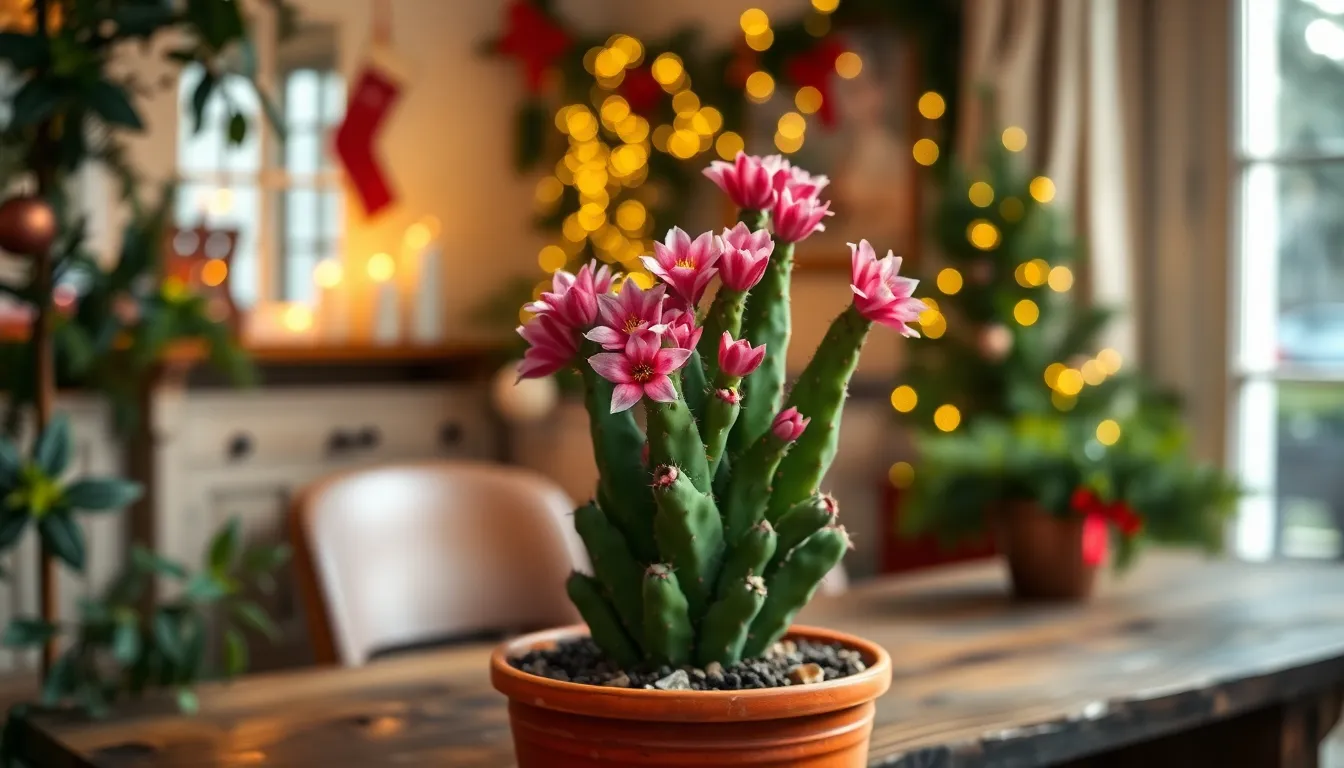
Christmas cacti reward us with stunning vibrant flowers during the winter months when most plants remain dormant. Getting these beautiful blooms requires understanding their unique flowering cycle and providing the right conditions at precisely the right times.
Setting Bud Formation Conditions
Temperature control plays the most critical role in triggering bud formation on our Christmas cacti. We need to expose our plants to cooler temperatures between 50°F and 55°F for 6 to 8 weeks during the fall months. This temperature drop mimics their natural environment and signals the plant to begin developing flower buds.
Rest periods become essential twice yearly to support the natural flowering cycles our plants follow. We should reduce watering frequency and allow our Christmas cacti to enter dormancy periods, which helps them conserve energy for spectacular blooming displays.
Soil moisture requires careful attention during bud formation since we want to keep the potting mix slightly moist but never waterlogged. Water only when the top inch of soil feels dry to our touch, and we must ensure excellent drainage to prevent root rot that can destroy developing buds.
Managing Light and Dark Periods
Darkness triggers the blooming process more than any other factor we can control. Our Christmas cacti need 12 hours of complete uninterrupted darkness each night for approximately 6 weeks during the fall season. We can achieve this by moving our plants to dark closets overnight or covering them with boxes to block all light sources.
Daylight exposure should provide 4 to 6 hours of bright indirect light during the bud formation period. We must avoid placing our plants in direct sunlight, which can burn the leaves and stress the plant when it needs to focus energy on developing flowers.
Location stability prevents stress that can abort developing buds on our Christmas cacti. We should choose spots away from frequently opened doors, heating vents, and drafty windows where temperature fluctuations might disrupt the delicate bud formation process.
Common Blooming Problems
Missing buds often result from insufficient darkness periods or temperatures that remain too warm during the critical fall bud setting phase. We need to ensure our plants receive proper light and temperature conditions for the full 6 to 8 week period.
Overwatering creates root rot conditions that prevent our Christmas cacti from developing healthy flower buds. Soggy soil suffocates roots and redirects the plant’s energy away from blooming toward survival, so we must maintain proper drainage and watering schedules.
Fertilizer timing can completely derail blooming if we feed our plants during the flowering period. We should avoid all fertilization once buds begin forming, as excess nutrients encourage leaf growth instead of flower development.
Direct sunlight exposure, particularly during spring and summer growing seasons, weakens our plants and creates pale or yellowing leaves that lack the strength to support abundant blooms. We must provide consistent bright indirect light throughout the year to maintain healthy plants capable of spectacular holiday flowering displays.
Troubleshooting Common Christmas Cactus Problems
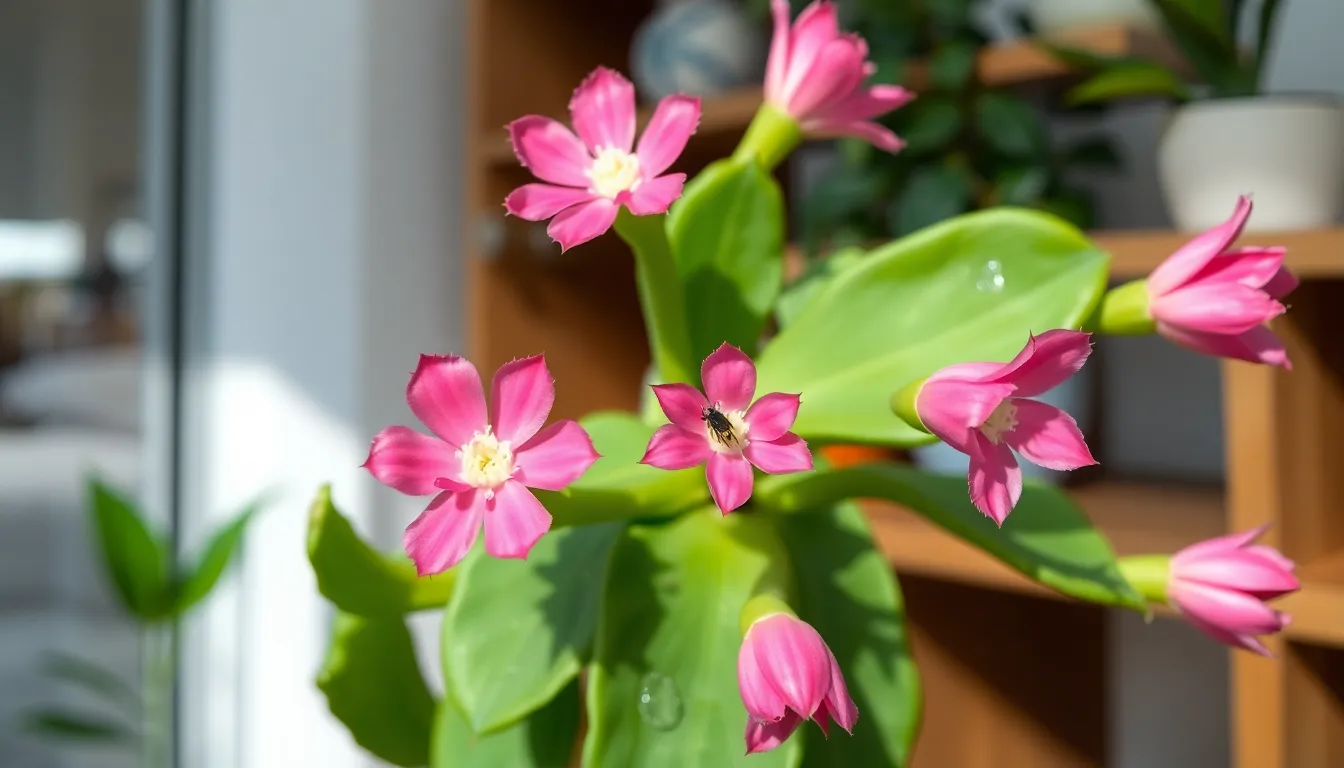
Even with proper care, Christmas cacti can occasionally encounter issues that require our attention. Understanding how to identify and address these problems quickly helps maintain the health and beauty of our plants.
Pest Issues and Answers
Mealybugs pose the most common threat to our Christmas cacti, appearing as white cottonlike insects that suck sap from plant segments. We can identify these pests by their distinctive fluffy appearance clustered around leaf joints and stems. Treatment involves wiping affected areas with rubbing alcohol-soaked cotton swabs or applying insecticidal soap spray directly to infested sections.
Spider mites create another frequent problem, manifesting as tiny red or brown specks that cause leaf discoloration and fine webbing on plant surfaces. These microscopic pests thrive in dry conditions and can quickly spread across our entire plant. Control measures include using specialized miticide treatments or gently washing leaves with lukewarm water to remove mites and their webs.
Flower thrips and fungus gnats may also target our Christmas cacti, requiring similar careful pest control approaches. Regular inspection of leaf surfaces and soil areas helps us catch infestations early before they become severe problems.
Disease Prevention and Treatment
Root rot develops as the primary disease concern for Christmas cacti, typically resulting from overwatering combined with poor drainage conditions. We can prevent this serious condition by using well-draining soil mixtures and watering only when the top half of soil feels dry to touch. Signs of root rot include yellowing leaves, musty soil odors, and soft black roots that require immediate attention.
Fungal infections often occur when humidity levels become excessive or air circulation remains inadequate around our plants. Proper spacing between plants promotes better airflow, while maintaining controlled humidity levels between 50% to 60% prevents moisture-related diseases. Clean pots and sterilized tools also reduce the risk of introducing harmful pathogens to our Christmas cacti.
Prompt removal of any diseased or damaged plant segments prevents the spread of infections to healthy portions of our cacti. We should always use clean, sharp tools when removing affected areas and dispose of diseased material away from other houseplants.
Leaf Drop and Other Concerns
Natural leaf drop occurs as part of the normal growth cycle, particularly after blooming periods when plants redirect energy toward new growth. But, excessive leaf loss often indicates environmental stress factors that we need to address promptly.
Overwatering and underwatering both trigger important leaf drop, with overwatered plants showing yellowing segments while underwatered plants display shriveled, dry leaves. Temperature fluctuations also cause stress-related leaf loss, especially when our plants experience sudden changes in their environment.
Direct heat sources and drafty areas create additional stress that leads to premature leaf drop in our Christmas cacti. We should avoid placing plants near heating vents, radiators, or frequently opened doors where temperature variations occur regularly. Consistent environmental conditions help minimize stress and maintain healthy leaf retention throughout the year.
Seasonal Care Tips for Year-Round Health
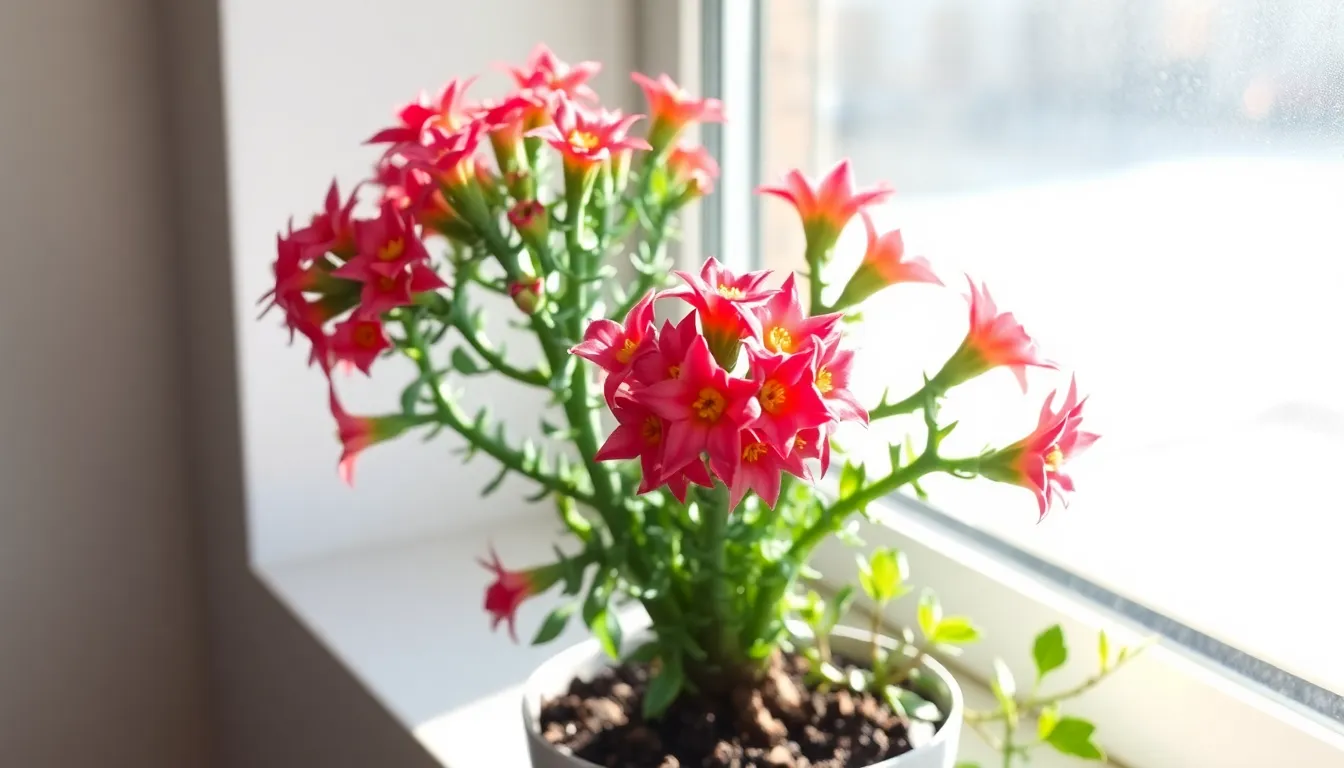
Adapting our care routine throughout the year ensures our Christmas cactus stays healthy and produces those stunning holiday blooms we love. Each season brings exact needs that help these tropical plants thrive in our homes.
Spring Care Routine
Position your Christmas cactus in bright, indirect sunlight during spring to encourage healthy growth without risking leaf burn. South-facing windows work perfectly when the plant stays a few feet back from direct rays.
Create the ideal growing medium by using well-draining potting mix, such as sandy cactus soil or general-purpose potting soil mixed with perlite. This combination prevents root rot from excess moisture while providing necessary nutrients.
Water moderately throughout spring by allowing the soil to dry almost completely between waterings. This watering pattern mimics their natural tropical rainforest habitat where they experience periods of dryness.
Feed your plant once in spring with a balanced, water-soluble fertilizer diluted to half strength to promote strong growth. Skip additional feeding until early summer to avoid overwhelming the plant with nutrients.
Summer Maintenance
Move your Christmas cactus outdoors to a shaded, protected location where it receives indirect light throughout the day. Direct sun exposure can cause leaves to become pale and stressed.
Continue watering when the top inch of soil feels dry to maintain slightly moist but never soggy conditions. Summer’s warmth increases the plant’s water needs compared to cooler months.
Feed monthly with balanced houseplant fertilizer to support the ongoing growth phase during warmer weather. Regular nutrition helps the plant build energy reserves for future blooming.
Protect from drafts and sudden temperature changes by choosing a stable location away from air conditioning units or frequently opened doors.
Fall Preparation for Blooming
Reduce watering significantly during fall to let your plant enter its natural rest period as it prepares for flowering. This dormant phase is crucial for bud development.
Provide cool temperatures around 50°F to 55°F for 6 to 8 weeks to trigger the formation of flower buds. Consistent cool conditions signal the plant to begin its blooming cycle.
Ensure 12 hours of uninterrupted darkness each night by placing your Christmas cactus in a closet or covering it completely. This photoperiod manipulation encourages bud formation naturally.
Stop fertilizing completely during fall preparation since nutrients can interfere with the plant’s natural flowering process.
Winter Care During Flowering
Maintain bright, diffused light for 4 to 6 hours daily to support blooming without stressing the plant during its most energy-intensive period. Adequate light helps flowers develop their full color potential.
Keep soil slightly moist but reduce watering frequency compared to the growing season to prevent root rot during the slower metabolism period. Check soil moisture regularly since heating systems can dry out potting mix faster.
Remove faded blooms promptly to redirect the plant’s energy toward producing new flowers rather than seed development. This deadheading practice extends the blooming period significantly.
Maintain warm room temperatures away from drafts and heating vents to prevent temperature shocks that can cause bud drop or flower failure.
Conclusion
With the right care approach Christmas cacti can become some of the most rewarding houseplants in our collection. These stunning tropical beauties aren’t just winter bloomers – they’re year-round companions that bring joy to our homes when we understand their unique needs.
We’ve covered everything from proper soil selection to seasonal light management because success with Christmas cacti comes from consistency and attention to detail. Remember that these plants thrive on routine and respond well to gradual changes rather than sudden shifts in their environment.
The effort we put into caring for our Christmas cacti pays off magnificently when those gorgeous blooms appear during the holiday season. There’s something truly special about nurturing a plant that rewards us with vibrant flowers just when we need them most – during the darker winter months.
Frequently Asked Questions
What makes Christmas cacti different from desert cacti?
Christmas cacti are tropical plants that originate from rainforests, not deserts. Unlike desert cacti, they require more water, indirect light, and higher humidity levels. They also need cooler temperatures in fall to trigger blooming and cannot tolerate direct sunlight, which can damage their leaves.
How often should I water my Christmas cactus?
Water your Christmas cactus every 1-2 weeks, allowing the top half of the soil to dry out between waterings. Check soil moisture by inserting your finger into the potting mix. Reduce watering in autumn to encourage blooming and adjust seasonally based on the plant’s growth cycle.
What type of soil is best for Christmas cacti?
Use well-draining sandy cactus mix or specialized cactus/succulent potting soil blended with perlite. Avoid dense, heavy soils that retain excessive water, as this can lead to root rot. Ensure your pot has drainage holes and test soil moisture before watering.
How much light does a Christmas cactus need?
Christmas cacti prefer bright, indirect light and should be positioned near east or north-facing windows. Avoid direct sunlight to prevent leaf damage. During fall, provide 12-14 hours of uninterrupted darkness for 6 weeks to trigger bud formation and encourage blooming.
What temperature is ideal for Christmas cacti?
Maintain temperatures between 65°F-70°F during the growing season. For blooming, provide cooler temperatures of 50°F-55°F for 6-8 weeks in fall. Avoid temperatures below 50°F or above 75°F, and keep plants away from heat sources and drafty areas.
When should I fertilize my Christmas cactus?
Fertilize once yearly in spring after flowering using balanced water-soluble fertilizer (10-10-10 or 20-20-20) diluted to half strength. Avoid fertilizing during the blooming period as this can hinder flower production. Signs of nutrient deficiency include slow growth and pale leaves.
How do I encourage my Christmas cactus to bloom?
Provide 12 hours of uninterrupted darkness each night for 6 weeks in fall, along with cooler temperatures (50°F-55°F). Reduce watering during this period and avoid fertilizing. Consistent bright indirect light during the day and proper rest periods are essential for blooming.
When should I repot my Christmas cactus?
Repot every 2-3 years, ideally in spring after the flowering period. This timing allows the plant to establish in new soil without disrupting its bloom cycle. Choose a pot with drainage holes and use well-draining cactus potting mix.
What are common problems with Christmas cacti?
Common issues include overwatering (yellowing leaves, soggy soil), underwatering (shriveled leaves), pest infestations (mealybugs, spider mites), and improper light exposure. Root rot from overwatering is particularly serious and can be prevented with proper drainage and watering techniques.
How do I increase humidity for my Christmas cactus?
Maintain humidity levels of 50-60% by grouping plants together, using pebble trays filled with water, or misting the air around the plant. Avoid getting water directly on the leaves to prevent fungal issues. Proper humidity mimics their native tropical environment.

